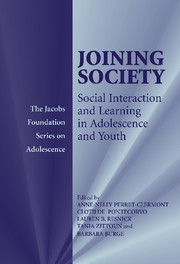Book contents
- Frontmatter
- Contents
- List of Contributors
- Foreword
- Preface
- I Introduction
- II Youth-Constructed Socialization
- III Personal Agency Through Collective Activity
- IV Learning in Practice and Discourse
- V Intergenerational Sites for Thinking
- 15 Thinking with Others: The Social Dimension of Learning in Families and Schools
- 16 The Role of Discourse in the Transformation of Parent–Adolescent Relationships
- 17 Interactive Minds: A Paradigm from Life Span Psychology
- 18 Thinking “Youth,” Thinking “School”: Social Representations and Fieldwork in Educational Research
- VI Pathways to Adulthood in National Context
- Index
- References
18 - Thinking “Youth,” Thinking “School”: Social Representations and Fieldwork in Educational Research
Published online by Cambridge University Press: 08 January 2010
- Frontmatter
- Contents
- List of Contributors
- Foreword
- Preface
- I Introduction
- II Youth-Constructed Socialization
- III Personal Agency Through Collective Activity
- IV Learning in Practice and Discourse
- V Intergenerational Sites for Thinking
- 15 Thinking with Others: The Social Dimension of Learning in Families and Schools
- 16 The Role of Discourse in the Transformation of Parent–Adolescent Relationships
- 17 Interactive Minds: A Paradigm from Life Span Psychology
- 18 Thinking “Youth,” Thinking “School”: Social Representations and Fieldwork in Educational Research
- VI Pathways to Adulthood in National Context
- Index
- References
Summary
Youth as a Cultural Construction
To speak of youth implies that these individuals have something in common, that they share certain experiences and preoccupations. Yet everyone has his or her own particular ideas about the meaning of youth or adolescence; one can also distinguish various approaches to apprehending this concept. For example, adolescence can be defined in physiological or biological terms when one refers to puberty. From a sociological or economic point of view, one might define youth as a key period for the construction of a stable identity or as a stage of transition from school to work. Thus, to speak of youth is actually a way of classifying or evaluating individuals. For some, young people are a source of innovation; for others, they form a group with its own set of values and its own culture that sometimes disturbs by its behavior. There are different types of discourse about youth, and each focuses on particular categories of behavior and social phenomena.
When the focus is on sociological factors, such as family traditions or modes of access to employment, one finds considerable differences in the meaning of youth according to country or culture (see Fouquet, this volume). In other words, a person's concept of youth depends on his or her membership in specific groups, and thus youth is largely a social construction.
- Type
- Chapter
- Information
- Joining SocietySocial Interaction and Learning in Adolescence and Youth, pp. 259 - 264Publisher: Cambridge University PressPrint publication year: 2003



